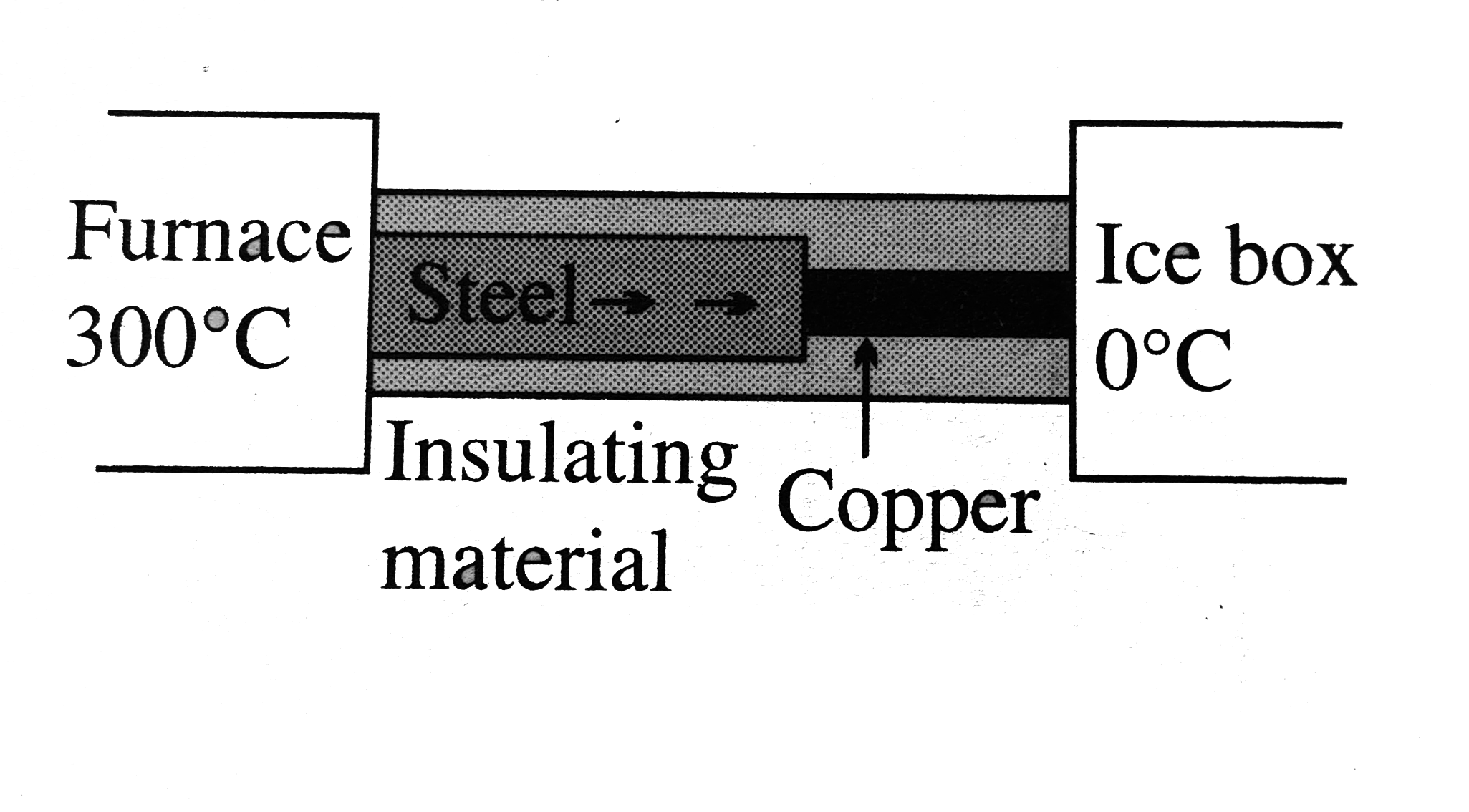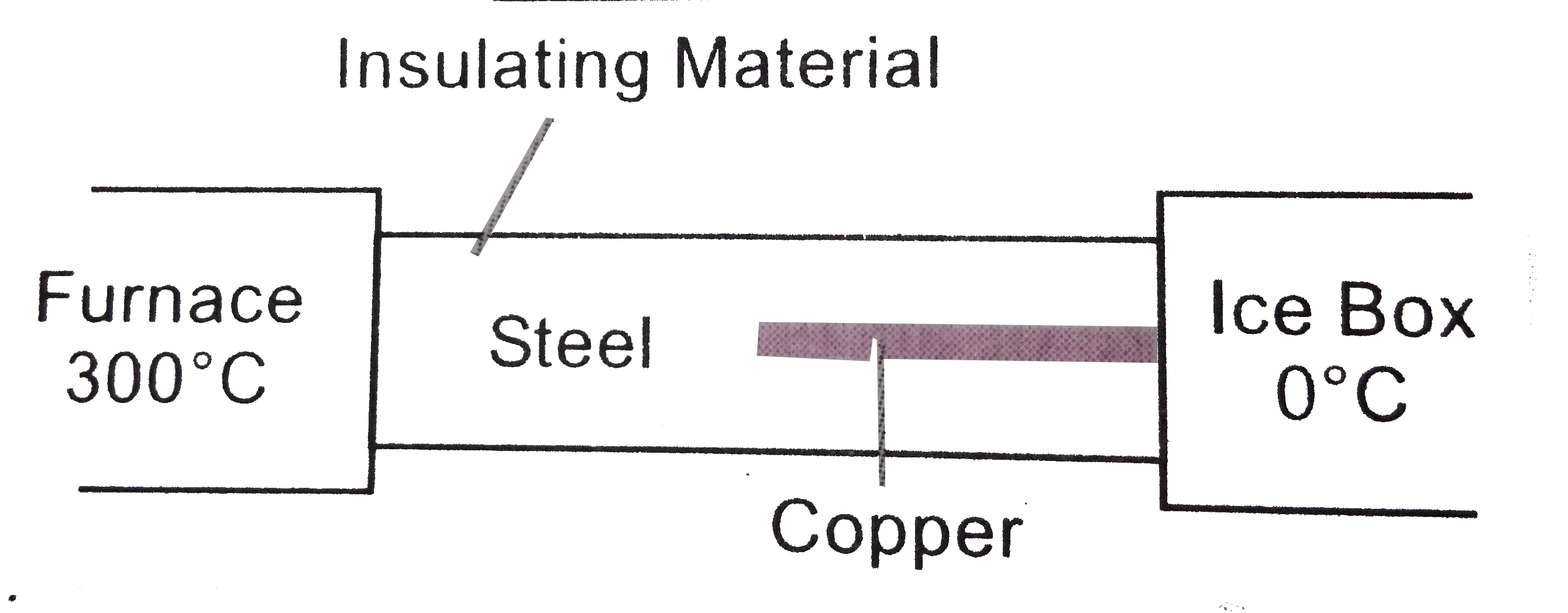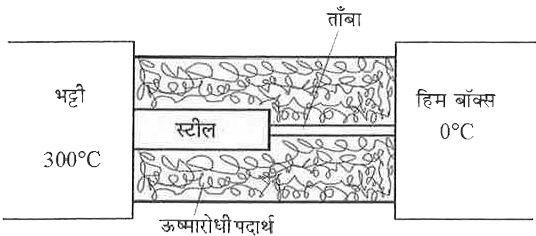What is the temperature of the steel - copper junction in the steady state of the system shown in Fig. Length of the steel rod = 15.0 cm, length of the copper rod = 10.0 cm, temperature of the furnace =400 ∘C, temperature of the other end =0 ∘C. The area of cross section of the steel rod is twice that of the copper rod.
(Thermal conductivity of steel =50.2 J s−1m−1K−1, and of copper =385 J s−1m−1 K−1).
 Solution in Gujrati
Solution in Gujrati
T=59.24∘C
Topper's Solved these Questions
- THERMAL PROPERTIES OF MATTERBook:KUMAR PRAKASHANChapter:THERMAL PROPERTIES OF MATTERExercise:Section - B (Numericals) Numerical From Textual Exercise
Explore 26 Videos
- THERMAL PROPERTIES OF MATTERBook:KUMAR PRAKASHANChapter:THERMAL PROPERTIES OF MATTERExercise:Section - B (Numericals) Numerical From Textual Exercise (Answer the following : )
Explore 4 Videos
- THERMAL PROPERTIES OF MATTERBook:KUMAR PRAKASHANChapter:THERMAL PROPERTIES OF MATTERExercise:Section - B (Numericals) Numerical From Textual Illustration
Explore 8 Videos
- SYSTEMS OF PARTICLES AND ROTATIONAL MOTIONBook:KUMAR PRAKASHANChapter:SYSTEMS OF PARTICLES AND ROTATIONAL MOTIONExercise:SECTION-F (SECTION-D) QUESTIONS PAPER
Explore 1 Video
- THERMODYANMICS Book:KUMAR PRAKASHANChapter:THERMODYANMICS Exercise:Question Paper
Explore 11 Videos
Similar Questions
The triple points of neon and carbon dioxide are 24.57 K and 216.55 respectively. Express these temperatures on the Celsius and Fahrenheit scales.
View SolutionThe triple - point of water is a standard fixed point in modern thermometry. Why ? What is wrong in taking the melting point of ice and the boiling point of water as standard fixed points (as was originally done in the Celsius scale) ?
View SolutionShow that the coefficient of area expansions, (ΔA/A)/ΔT, of a rectangular sheet of the solid is twice its linear expansively, αl.(αl=10−5K−1)
View SolutionA rope of negligible mass is wound round a hollow cylinder of mass 3 kg and radius 40 cm. What is the angular acceleration of the cylinder if the rope is pulled with a force of 30 N? What is the linear acceleration of the rope? Assume that there is no slipping.
View SolutionWhy is a steam burn more damaging than a burn with boiling water of the same ?
View Solution
What is the temperature of the steel-copper junction in the steady state of the system shown if Fig? Length of the steel rod =25cm, length of the copper rod=50cm, temperature of the furnace=300∘C, temperature of the other end =0∘C. The area of cross section of the steel rod is twice that of the copper rod. (Thermal conductivity of steel =50J/sm and of copper =400Js/mK).
View SolutionWhat is the temperature of steel-copper jumction in the steady state of the system shown in fig. Length of the steel rod = 30.0 cm, length of the copper rod = 20.0 cm, temperature of the furnace = 300^(@)C , temperature of cold end =0^(@)C . The area of cross-section of the steel rod is twice that of the copper rod. thermal conductivity of steel = 50 .2 Js^(-1) m^(-1) .^(@)C^(-1) and of copper = 358 Js^(-1) m^(-1) .^(@)C^(-1) .
View SolutionWhat is the temperature of the steel-copper junction in the steady state system show in Fig. 7(e).17? Length of steel rod = 15.0 cm, length of the copper rod = 10.0 cm, temperature of the furnace =300∘C, temperature of other end 0∘C. The are of cross-section of the steel rod is twice that of the copper rod. (Thermal conductivity of steel =50.2js−1m−1K−1 and of copper =3895js−1m−1K−1).

View SolutionWhat is the temperature of the steel -copper junction in the steady state of the system shown in the figure. Length of the steel rod =25cm , length of the copper rod =50cm , temperature of the furance =300^(@)C , temperature of the other end =0^(@)C . The area of cross section of the steel rod is twice that of the copper rod. (Thermal conductivity of steel =50Js^(-1)m^(-1)K^(-1) and of copper =400 J s^(-1)m^(-1)K^(-1) )
View SolutionCylinder copper rod of length 1m and a cylinder steel rod of length 1.5m are joined together end to end. The cross sectional area of eac rod is 3.14cm . The free ends of steel rod and copper rods are maintained at 0^(@)C and 100^(@)C respectively. The surfaces of rods are thermally insulated. Find the temperature of copper steel junction. (Given thermal conductivity of steel =46J//m-s.^(@)C and the thermal conductivity of copper =386J//m-s.^(@)C )
View Solutionचित्र 11.15 में दर्शाए गए निकाय की स्थाई अवस्था में स्टील - ताँबा संधि का ताप क्या है ? स्टील छड़ की लंबाई = 15.0 cm, ताँबे की छड़ की लंबाई = 10.0 cm, भट्ठी का ताप = 300∘C, दुसरे सिरे का ताप = 0∘C , स्टील की छड़ की अनुप्रस्थ काट के क्षेत्रफल ताँबे की छड़ की अनुप्रस्थ काट के क्षेत्रफल का दो गुना है | (स्टील की ऊष्मा चालकता = 50.2 J s−1m−1K−1, ताँबे की ऊष्मा चालकता = 385Js−1m−1K−1)
View Solutionस्टील तथा ताँबे की छड़ की लंबाई क्या होनी चाहिए की सभी तापो पर स्टील की छड़ की लंबाई ताँबे की छड़ से 5 सेमी अधिक रहे | ( ताँबे के लिए α=1.7×10−5 प्रति .∘Cस्टील के लिए 11×10−5प्रति )
View Solutionनिकाय की स्थायी अवस्था में स्टील ताँबा संधि का ताप क्या है ? स्टील छड़ की लंबाई =15.0 cm , ताँबे की छड़ की लंबाई= 10.0 cm , भट्टी का ताप=300∘C , दूसरे सिरे का ताप=0∘C , स्टील की छड़ के अनुप्रस्थ काट का क्षेत्रफल ताँबा का दो गुना है ( स्टील की ऊष्मा चालकता=50.2Js−1m−1K−1 , ताँब की ऊष्मा चालकता=385Js−1m−1K−1 )
View Solutionचित्र में दर्शाये गये निकाय की स्थायी अवस्था में स्टील तांबा संधि का माप क्या है? स्टील छड़ की लम्बाई =15.0cm तांबे की छड़ की लम्बाई =10.0cm भट्टी का ताप =300∘C, दूसरे सिरे का ताप =0∘C, स्टील की छा़ की अनुप्रस्थ काट का क्षेत्रफल तांबे की छड़ की अनुप्रस्थ काट के क्षेत्रफल का दोगुना है। स्टील की ऊष्मा चालकता =50.2JS−1m−1K−1, तांबे की ऊष्मा चालकता =385JS−1m−1K−1

View SolutionWhat is the temperature of the steel - copper junction in the steady state of the system shown in Fig.11.15. Length of the steel rod = 15.0 cm, length of the copper reod = 10.0 cm, temperarure of the furnace = 300 ^(@) C , temperature of the furnace = 300 ^(@) C , temperature of the other end = 0^(@) C . The are of cross section of the steel rod is twice that of the copper rod. ( Thermal conductivity of steel = 50.2 J s^(-1) m^(-1) K^(-1) , and of copper = 385 J s^(-1) m^(-1) K^(-1)) .
View Solution
